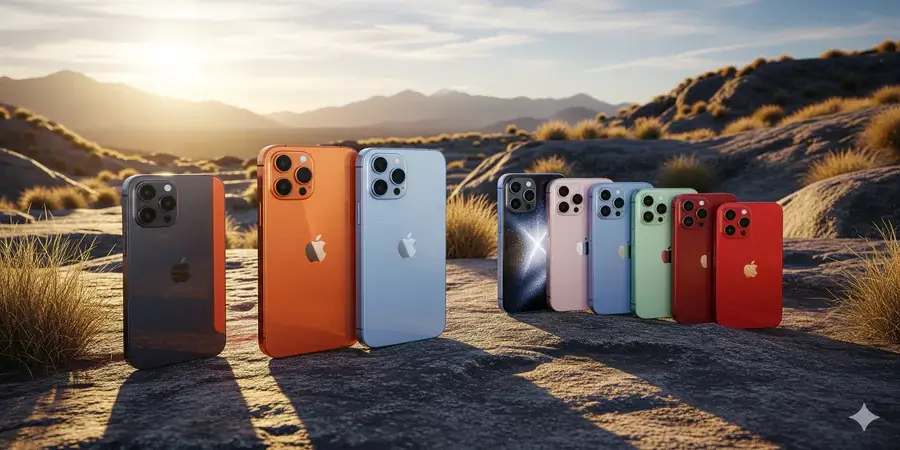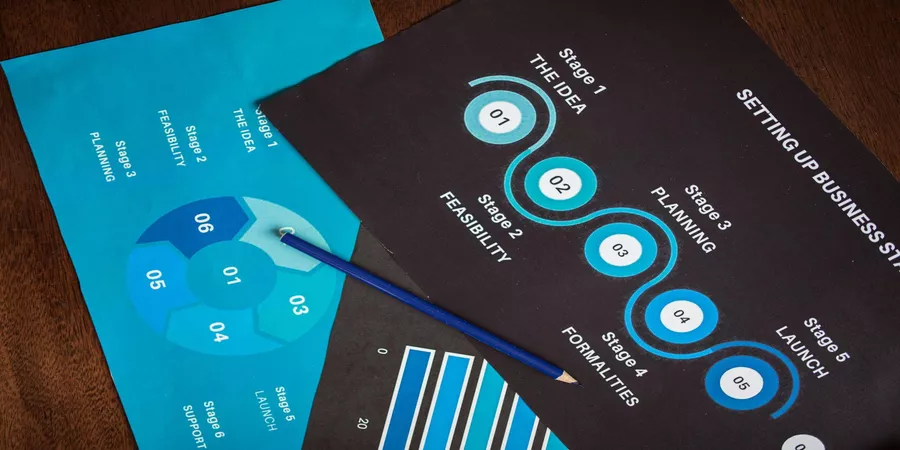Apple’s September 9, 2025 “Awe Dropping” event will unveil the most colorful iPhone lineup in company history, featuring 15 distinct color options across three model tiers. The iPhone 17 series introduces bold new finishes including a striking copper-orange Pro variant and ultra-light sky-blue Air model, marking Apple’s most aggressive color strategy since the iPhone 12 generation. This comprehensive palette expansion represents a strategic shift toward personalization and market differentiation as smartphone hardware capabilities plateau across industry players.
Complete iPhone 17 Color Portfolio Breakdown
Apple’s color strategy for the iPhone 17 series demonstrates sophisticated market segmentation through carefully curated palettes that reflect each model’s positioning and target demographic.

iPhone 17 Lineup: Complete Color Options Across All Models
iPhone 17 Standard (6 Colors):
- Black (Classic)
- White (Pure)
- Steel Gray (Pantone 400 TPG)
- Green (Pantone 2282 U – Vibrant lime)
- Purple (Pantone 530 U – Refined tone)
- Light Blue (Pantone 658 U)
iPhone 17 Air (4 Colors):
- Black (Minimalist)
- White (Clean)
- Light Blue (Sky variant – Pantone 657 U)
- Light Gold/Gardenia (Champagne finish)
iPhone 17 Pro/Pro Max (5 Colors):
- Black (Professional)
- White (Premium)
- Gray (Traditional)
- Dark Blue/Mood Indigo (Sophisticated)
- Orange/Copper (Revolutionary metallic)
This 15-option portfolio represents Apple’s most comprehensive color offering since the company began differentiating iPhone models by price tier, with each segment receiving distinct treatment aligned with consumer expectations and manufacturing capabilities.
Revolutionary Copper Orange Pro Finish Signals Premium Strategy
The iPhone 17 Pro’s copper-orange finish represents Apple’s boldest color decision for flagship models in over a decade. Bloomberg’s Mark Gurman confirmed this warm-toned metallic option, which undergoes specialized dual-anodization processes to achieve fluorescent characteristics under varying lighting conditions.
Manufacturing complexity details include:
- New anodization techniquesspecifically developed for warm-toned aluminum finishing
- Enhanced quality control protocolsensuring color consistency across global production facilities
- Environmental testing standardsvalidating color stability under extreme conditions
- Component coordinationwith camera module and accessory manufacturers for color matching
Industry sources indicate the copper finish has completed Apple’s rigorous engineering validation testing, with production components entering manufacturing six to eight weeks ahead of the September launch. This timeline suggests strong internal confidence in both market appeal and manufacturing feasibility.
The decision to introduce such a distinctive color reflects Apple’s analysis of premium smartphone competition, where Samsung’s Galaxy S25 Ultra and Google’s Pixel 9 Pro have emphasized unique finishes to differentiate from standard black, white, and gray options.
Material Strategy Revolution: Aluminum Returns to Pro Models
Apple’s iPhone 17 material allocation represents a strategic reversal, with Pro models returning to aluminum frames while the ultra-thin Air model exclusively utilizes titanium. This counterintuitive approach prioritizes structural requirements over traditional premium positioning.
Material Distribution Logic:
- iPhone 17 Standard:Aluminum enables cost-effective manufacturing while supporting six vibrant color options
- iPhone 17 Air:Titanium’s superior strength-to-weight ratio essential for 5.5mm thickness structural integrity
- iPhone 17 Pro:Aluminum’s enhanced anodization capabilities enable bold copper finish while reducing manufacturing costs
The titanium-to-aluminum transition for Pro models reflects Apple’s engineering pragmatism, where material selection serves functional rather than purely marketing purposes. Aluminum’s superior color-holding properties enable the expanded Pro palette while maintaining durability standards.
This material strategy also addresses manufacturing scalability, as aluminum anodization processes scale more efficiently than titanium finishing for high-volume production across Apple’s global supply chain.
Sky Blue Air Model Establishes Design Continuity
The iPhone 17 Air’s light blue finish creates visual continuity with the M4 MacBook Air’s Sky Blue option, establishing a cohesive “Air” family aesthetic across Apple’s product portfolio. This color coordination reflects Apple’s broader design philosophy of product family coherence.
Sky Blue Technical Specifications:
- Pantone 657 U referenceensuring consistent reproduction across manufacturing batches
- Lightest blue ever producedby Apple, appearing nearly white under low-light conditions
- Marketing emphasison ultra-thin 5.5mm profile and 145-gram weight
- Material optimizationdesigned to complement the Air’s minimalist design language
The Light Gold/Gardenia alternative provides a sophisticated champagne tone that appeals to users seeking understated luxury without the boldness of traditional gold finishes. This refined approach aligns with the Air model’s positioning as a premium ultra-portable device.
Market Positioning Strategy Through Color Differentiation
Apple’s expanded color palette directly responds to increased competition in the premium smartphone segment, where design differentiation becomes crucial as hardware capabilities commoditize across manufacturers.
Consumer Research Insights:
- Strong preference for color variety among younger demographics viewing smartphone color as personal expression
- Regional market variations with specific hues showing stronger demand in key growth markets
- Premium segment demand for distinctive luxury aesthetics beyond traditional conservative options
The six-color standard iPhone 17 palette addresses mainstream market demand for self-expression, while Pro model exclusives maintain premium positioning through unique finishes unavailable in lower tiers.
Competitive Response Indicators:
- Samsung accelerating Galaxy color variant development following Apple’s strategy leaks
- Google exploring premium finishes for future Pixel releases
- Industry-wide shift toward design differentiation as technical specifications plateau
Strategic Business Implications for Tech Industry
Apple’s color strategy signals broader industry evolution toward personalization and aesthetic differentiation as primary competitive advantages in mature smartphone markets.
Industry Impact Analysis:
- Manufacturing Innovation:New anodization techniques developed for iPhone 17 will likely influence broader consumer electronics finishing standards
- Supply Chain Coordination:Enhanced color consistency requirements drive supplier capability improvements across the ecosystem
- Market Segmentation:Color-based differentiation enables price tier management while maintaining brand coherence
Future Product Development Trends:
- Increased emphasis on distinctive design elements as hardware performance gains diminish
- Cross-product color coordination establishing family aesthetics across device categories
- Premium finish techniques expanding beyond smartphones to accessories and wearables
Launch Timeline and Market Availability Strategy
Apple’s September 9, 2025 launch maintains the company’s traditional fall release schedule while ensuring simultaneous availability across all color variants to avoid the staggered releases that have characterized some previous launches.
Production Allocation Strategy:
- Unified global launch preventing regional color preference disparities
- Enhanced manufacturing capacity allocated for anticipated high demand for distinctive finishes
- Particular emphasis on copper orange Pro models due to collector interest and social media appeal
Industry analysts project the comprehensive color strategy will drive upgrade rates among existing iPhone users seeking design refresh while attracting competitive platform switchers drawn to unique aesthetic options.
Frequently Asked Questions
Q: Which iPhone 17 model offers the most color options? A: The standard iPhone 17 provides six color choices (Black, White, Steel Gray, Green, Purple, Light Blue), making it the most diverse option in the lineup.
Q: Why did Apple choose copper orange for Pro models? A: The copper orange finish represents Apple’s strategic move toward bold differentiation in the premium segment, responding to increased competition from Samsung and Google flagship models.
Q: What materials are used across the iPhone 17 lineup? A: Standard iPhone 17 and Pro models use aluminum frames enabling vibrant colors, while the Air model exclusively utilizes titanium for structural integrity at 5.5mm thickness.
Q: When will the new colors be available? A: All iPhone 17 colors launch simultaneously on September 19, 2025, following the September 9 announcement and September 12 pre-order start date.
Q: How does the Air’s blue compare to previous iPhone blues? A: The iPhone 17 Air’s sky blue (Pantone 657 U) is Apple’s lightest blue ever produced, appearing almost white under certain lighting conditions.
Q: Will the new colors affect pricing? A: Apple typically maintains consistent pricing across color variants within each model tier, with no premium charged for distinctive finishes like copper orange.
Q: What manufacturing techniques enable the new colors? A: Apple developed new dual-anodization processes specifically for complex finishes, with enhanced quality control ensuring color consistency across global production facilities.
The iPhone 17’s revolutionary color strategy represents more than aesthetic evolution—it signals Apple’s recognition that design differentiation has become crucial for maintaining competitive advantage in mature smartphone markets. As hardware capabilities plateau across industry players, distinctive visual identity emerges as a primary purchase driver.
This comprehensive color expansion, led by the bold copper orange Pro finish and sophisticated Air palette, demonstrates Apple’s confidence in consumer appetite for self-expression through technology choices. The success of this strategy will likely influence not only future iPhone designs but the broader consumer electronics industry’s approach to product differentiation.
How will Apple’s bold color strategy influence your organization’s product design philosophy? What role should aesthetic differentiation play in mature technology markets where functional advantages increasingly narrow?







